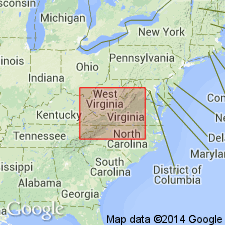
- Usage in publication:
-
- Pilot Gneiss
- Modifications:
-
- Named
- Dominant lithology:
-
- Gneiss
- AAPG geologic province:
-
- Piedmont-Blue Ridge province
Summary:
The Pilot Gneiss is here named in the Pedlar massif in the Virginia Blue Ridge. It is an intrusive leuco-granulite gneiss with small hornblende granitoid bodies. Age is Middle Proterozoic.
Source: GNU records (USGS DDS-6; Reston GNULEX).

- Usage in publication:
-
- Pilot Gneiss
- Modifications:
-
- Overview
- AAPG geologic province:
-
- Piedmont-Blue Ridge province
Summary:
Appears to be youngest unit in the Pedlar massif. Occurs primarily as two large intrusive complexes within the Radford sheet. Dominant rock type is medium to coarse-grained and contains less than 50 percent quartz, 25 to 45 percent perthitic feldspar, and less than 30 percent green hornblende. Assemblage of rock types is atypical of Grenvillian rocks.
Source: GNU records (USGS DDS-6; Reston GNULEX).
For more information, please contact Nancy Stamm, Geologic Names Committee Secretary.
Asterisk (*) indicates published by U.S. Geological Survey authors.
"No current usage" (†) implies that a name has been abandoned or has fallen into disuse. Former usage and, if known, replacement name given in parentheses ( ).
Slash (/) indicates name conflicts with nomenclatural guidelines (CSN, 1933; ACSN, 1961, 1970; NACSN, 1983, 2005, 2021). May be explained within brackets ([ ]).

